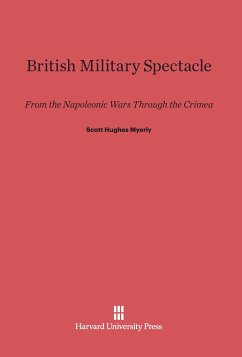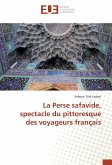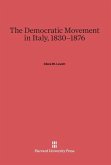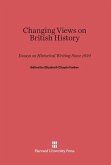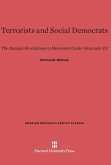In the theater of war, how important is costume? And in peacetime, what purpose does military spectacle serve? This book takes us behind the scenes of the British military at the height of its brilliance to show us how dress and discipline helped to mold the military man and attempted to seduce the hearts and minds of a nation while serving to intimidate civil rioters in peacetime.
Often ridiculed for their constrictive splendor, British army uniforms of the early nineteenth century nonetheless played a powerful role in the troops' performance on campaign, in battle, and as dramatic entertainment in peacetime. Plumbing a wide variety of military sources, most tellingly the memoirs and letters of soldiers and civilians, Scott Hughes Myerly reveals how these ornate sartorial creations, combining symbols of solidarity and inspiration, vivid color, and physical restraint, enhanced the managerial effects of rigid discipline, drill, and torturous punishments, butalso helped foster regimental esprit de corps.
Encouraging recruitment, enforcing discipline within the military, and boosting morale were essential but not the only functions of martial dress. Myerly also explores the role of the resplendent uniform and its associated gaudy trappings and customs during civil peace and disorder--whether employed as public relations through spectacular free entertainment, or imitated by rioters and rebels opposing the status quo. Dress, drills, parades, inspections, pomp, and order: as this richly illustrated book conducts us through the details of the creation, design, functions, and meaning of these aspects of the martial image, it exposes the underpinnings of a mentality--and vision--that extends far beyond the military subculture into the civic and social order that we call modernity.
Often ridiculed for their constrictive splendor, British army uniforms of the early nineteenth century nonetheless played a powerful role in the troops' performance on campaign, in battle, and as dramatic entertainment in peacetime. Plumbing a wide variety of military sources, most tellingly the memoirs and letters of soldiers and civilians, Scott Hughes Myerly reveals how these ornate sartorial creations, combining symbols of solidarity and inspiration, vivid color, and physical restraint, enhanced the managerial effects of rigid discipline, drill, and torturous punishments, butalso helped foster regimental esprit de corps.
Encouraging recruitment, enforcing discipline within the military, and boosting morale were essential but not the only functions of martial dress. Myerly also explores the role of the resplendent uniform and its associated gaudy trappings and customs during civil peace and disorder--whether employed as public relations through spectacular free entertainment, or imitated by rioters and rebels opposing the status quo. Dress, drills, parades, inspections, pomp, and order: as this richly illustrated book conducts us through the details of the creation, design, functions, and meaning of these aspects of the martial image, it exposes the underpinnings of a mentality--and vision--that extends far beyond the military subculture into the civic and social order that we call modernity.
The book is well written [and] the research is excellent. Myerly has consulted a very wide range of materials, judiciously using secondary sources and drawing a wealth of information from primary sources. The abundance of fascinating detail alone makes this an attractive study to anyone remotely interested in the British military in particular or British culture in general.
This is an original and fascinating discussion of a critical yet subtle subject heretofore completely overlooked by scholars of war history. This book studies the most visible aspect of British state imagery during the first half of the nineteenth century: military or martial spectacle as seen in uniforms, parades, pictures, music, art, and song. This is an account of how imagery was a vital part of nineteenth century military management in London's effort to mold the beliefs and actions of its soldiers into expert war tools. In doing this Myerly argues effectively that the imagery's effect held important consequences for British society as well as British soldiers.
No other book has tried to look at how military dress and mannerism interacted with details of civil society like the circus! The energy of research behind this book is impressive. Myerly has read very widely...The theme he addresses is a real one: military show did matter in British life, and affected soldiers and civilians alike.
[T]he work is thought provoking and...well illustrated.
The British Army is well known for its pomp and pageantry, color and precision drill. Nowhere in its history is this more evident than the period from 1800 to 1857, when the army was at its pinnacle and almost continuously engaged in one campaign or another. This is the first book to take an in-depth look at the purpose and importance of military costume and spectacle in time of war and peace...Recommended.
Myerly explores very effectively the psychological impact of military dress on both soldiers and civilians. His probing into the various meanings behind the sartorial finery, and its presentation in public as 'spectacle', reveals a complex picture in which the context of the presentation is all important...He makes too, a welcome contribution on the often puzzling, and at times paradoxical relationship between British soldiers and civilians. For those interested specifically in military dress, there is much comment drawn from primary sources, supported by a well chosen (and well reproduced) selection of contemporary illustrations, half of which are in colour...For the student of military history, and of the British Army and its uniforms in particular, this is a book that has much of interest. It can be interesting and insightful.
This well-written and ably-argued study takes an apparently thankless subject--military uniform--and shows it can be employed to throw light on the military, society and politics of the period...Based on a most impressive and imaginative range of archival and published sources, [Myerly's] book offers not only valuable insights on military history, but also an important perspective on the issue of British exceptionalism.
[A] beautifully produced volume...Myerly has written a book that is often innovative, fusing written evidence with that of pictures and artefacts, and linking antiquarianism to broad historical themes in the best manner of cultural history.
[An] earnest foray into military aesthetics. There have been innumerable books about army uniforms and traditions, but Myerly, an American cultural and military historian, is concerned also with the impact on society of military spectacle and of those martial virtues and excellences...It is good to see American publishers backing research into facets of British history which our own publishers are eager to neglect.
This book is as beautifully tailored as are the uniforms it describes...[It] is a most entertaining and scholarly work. Charm comes with the author's pleasure in anecdotes.
This is an original and fascinating discussion of a critical yet subtle subject heretofore completely overlooked by scholars of war history. This book studies the most visible aspect of British state imagery during the first half of the nineteenth century: military or martial spectacle as seen in uniforms, parades, pictures, music, art, and song. This is an account of how imagery was a vital part of nineteenth century military management in London's effort to mold the beliefs and actions of its soldiers into expert war tools. In doing this Myerly argues effectively that the imagery's effect held important consequences for British society as well as British soldiers.
No other book has tried to look at how military dress and mannerism interacted with details of civil society like the circus! The energy of research behind this book is impressive. Myerly has read very widely...The theme he addresses is a real one: military show did matter in British life, and affected soldiers and civilians alike.
[T]he work is thought provoking and...well illustrated.
The British Army is well known for its pomp and pageantry, color and precision drill. Nowhere in its history is this more evident than the period from 1800 to 1857, when the army was at its pinnacle and almost continuously engaged in one campaign or another. This is the first book to take an in-depth look at the purpose and importance of military costume and spectacle in time of war and peace...Recommended.
Myerly explores very effectively the psychological impact of military dress on both soldiers and civilians. His probing into the various meanings behind the sartorial finery, and its presentation in public as 'spectacle', reveals a complex picture in which the context of the presentation is all important...He makes too, a welcome contribution on the often puzzling, and at times paradoxical relationship between British soldiers and civilians. For those interested specifically in military dress, there is much comment drawn from primary sources, supported by a well chosen (and well reproduced) selection of contemporary illustrations, half of which are in colour...For the student of military history, and of the British Army and its uniforms in particular, this is a book that has much of interest. It can be interesting and insightful.
This well-written and ably-argued study takes an apparently thankless subject--military uniform--and shows it can be employed to throw light on the military, society and politics of the period...Based on a most impressive and imaginative range of archival and published sources, [Myerly's] book offers not only valuable insights on military history, but also an important perspective on the issue of British exceptionalism.
[A] beautifully produced volume...Myerly has written a book that is often innovative, fusing written evidence with that of pictures and artefacts, and linking antiquarianism to broad historical themes in the best manner of cultural history.
[An] earnest foray into military aesthetics. There have been innumerable books about army uniforms and traditions, but Myerly, an American cultural and military historian, is concerned also with the impact on society of military spectacle and of those martial virtues and excellences...It is good to see American publishers backing research into facets of British history which our own publishers are eager to neglect.
This book is as beautifully tailored as are the uniforms it describes...[It] is a most entertaining and scholarly work. Charm comes with the author's pleasure in anecdotes.

